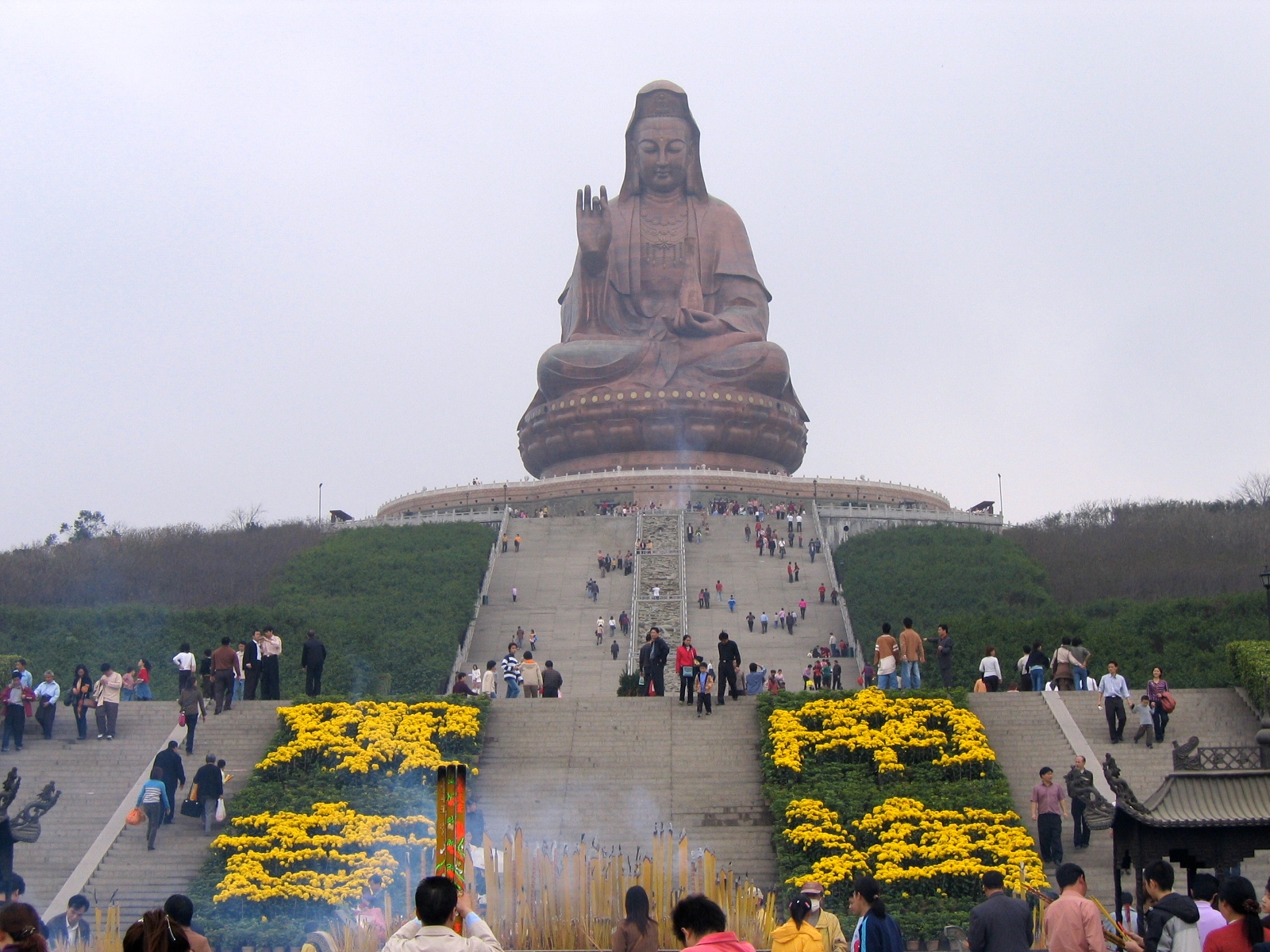|
Nanhai District
Nanhai District (), is a district of Foshan, Guangdong, China. Its government is the first to have developed e-government informatization at the county level in China. History Establishment of Nanhai is traditionally attributed two brothers carrying their father's bowls in 1271. They were fleeing south from the Mongols on a bamboo raft when a violent storm shipwrecked them and broke all the bowls. The brothers settled down there and the position of the wreck is commemorated by a shrine. This area was named Broken Bowls Point. On 15 February 1921, the eastern part of Nanhai County was ceded to the newly established City of Guangzhou which became part of what is now western part of Liwan. On 26 June 1951, Foshan Town (present Chancheng) was ceded to the newly established City of Foshan. Nanhai County was upgraded into a county-level city on 2 September 1992 until 8 December 2002 Nanhai was consolidated as a district of Foshan. Administration division Nanhai was a county-level ... [...More Info...] [...Related Items...] OR: [Wikipedia] [Google] [Baidu] |
District (PRC)
The term ''district'', in the context of China, is used to refer to several unrelated political divisions in both ancient and modern China. In the modern context, district (), formally city-governed district, city-controlled district, or municipal district (), are subdivisions of a Municipality of China, municipality or a prefecture-level city. The rank of a district derives from the rank of its city. Districts of a municipality are Prefecture (China), prefecture-level; districts of a sub-provincial city are sub-prefecture-level; and districts of a prefecture-level city are Counties of China, county-level. The term was also formerly used to refer to obsolete District (China)#County-controlled districts (obsolete), county-controlled districts (also known as district public office). However, if the word ''district'' is encountered in the context of ancient History of China, Chinese history, then it is a translation for ''History of the administrative divisions of China, xian'' ... [...More Info...] [...Related Items...] OR: [Wikipedia] [Google] [Baidu] |
Chancheng District
Chancheng District is a district and the seat of the city of Foshan, Guangdong Province, China. Chancheng is the economic, cultural and political center of the city. History Chancheng belonged to the land of Baiyue during the Spring and Autumn and Warring States period, Panyu County from the Qin Dynasty to the North and South dynasties, Nanhai County from the Sui dynasty in 590 to the Tang dynasty, Xianning County during the Five Dynasties and Ten Kingdoms period in 917, and Nanhai County from the Song dynasty in 972 to the Qing dynasty. Geography The district lies at the center of Foshan, surrounded on the east, west, and north sides by the Nanhai District and bordered to the south by the Shunde District. Chancheng District is located in the hinterland of the Pearl River Delta, southwest of Guangzhou and central Foshan, bordering Nanhai District to the east, west and north, and Shunde District to the southeast and south, with a length of 15 km from north to south and a wid ... [...More Info...] [...Related Items...] OR: [Wikipedia] [Google] [Baidu] |
Kang Youwei
Kang Youwei (; Cantonese: ''Hōng Yáuh-wàih''; 19March 185831March 1927) was a prominent political thinker and reformer in China of the late Qing dynasty. His increasing closeness to and influence over the young Guangxu Emperor sparked conflict between the emperor and his adoptive mother, the regent Empress Dowager Cixi. His ideas were influential in the abortive Hundred Days' Reform. Following the coup by Cixi that ended the reform, Kang was forced to flee. He continued to advocate for a Chinese constitutional monarchy after the founding of the Republic of China. Early life Kang was born on 19March 1858 in Su Village, Danzao Town, Nanhai County, Guangdong province (now the Nanhai District of Foshan City). According to his autobiography, his intellectual gifts were recognized in his childhood by his uncle. As a result, from an early age, he was sent by his family to study the Confucian classics to pass the Chinese civil service exams. However, as a teenager, he ... [...More Info...] [...Related Items...] OR: [Wikipedia] [Google] [Baidu] |
Kang Tongbi
Kang Tongbi (; 1887–1969), also romanized as Kang Tung Pih, was the daughter of Kang Youwei, a Chinese reformer and political figure of the late Qing dynasty and early Republican era. Early life In 1880, Kang was born in Southern China. Official documents in the US indicate that her birth was on February 5, 1888, using the Gregorian calendar. Kang's father was Kang Youwei. Kang's mother was Zhang Yunchu, first wife. Kang's family was relatively wealthy in traditional China. Kang's father kept several wives and concubines. She was Zhang Yunchu's second daughter. Kang Tongbi's father, along with his disciple Liang Qichao, was one of the major intellectual figures behind the launching of China's political reform by the Guangxu Emperor in 1898, but political infighting at the Qing court caused the reform movement to be summarily aborted within 103 days of its start, and a death warrant to be issued against Kang Youwei. He hastily left the country with his family and would spe ... [...More Info...] [...Related Items...] OR: [Wikipedia] [Google] [Baidu] |
Xiqiao, Guangdong
Xiqiao Town () is a town in Nanhai District, Foshan, Guangdong, China. It covers an area of 176.63 square kilometres with registered population of 144,700 and floating population of 70,000. Tourism and textiles are the main industries in the town. Xiqiao Mountain (), a famous mountain and scenic spot in Southern Guangdong, is also located at Xiqiao. Tourism Xiqiao Mountain is a beautiful scenic spot boasting of a massive metallic sitting Buddha Statue (called the Nanhai Guanyin Bhusa). It can be reached by an hour's hike from the foot of the hill or by car. Evening times are less crowded, and cheaper to visit. It is especially beautiful when illuminated in the dark.See also * |
Shishan, Foshan
Shishan Town () is a town in Nanhai District, Foshan, Guangdong, China China, officially the People's Republic of China (PRC), is a country in East Asia. It is the world's List of countries and dependencies by population, most populous country, with a Population of China, population exceeding 1.4 billion, slig .... Transport * Shishan railway station External links Nanhai District Towns in Guangdong {{Foshan-geo-stub ... [...More Info...] [...Related Items...] OR: [Wikipedia] [Google] [Baidu] |
Dali, Guangdong
Dali () is a town in Nanhai District, located to the north of the downtown Foshan, Guangdong Guangdong (, ), alternatively romanized as Canton or Kwangtung, is a coastal province in South China on the north shore of the South China Sea. The capital of the province is Guangzhou. With a population of 126.01 million (as of 2020 ..., People's Republic of China. It is mainly famous for its aluminium extrusion industry. Situated at the junction of two major highways, the 321 and 325 national highways. , it administers the following 42 residential neighborhoods: *Liyuan Community () *Linan Community () *Lixiong Community () *Lixing Community () *Zhijie Community () *Liucun Community () *Huaxia Community () *Qiyang Community () *Jiayi Community () *Dongting Community () *Jiangbei Community () *Libei Community () *Lidong Community () *Lixi Community () *Lizhong Community () *Yayao Community () *Lianjiao Community () *Fengchi Community () *Shuitou Community () *Qicha Communit ... [...More Info...] [...Related Items...] OR: [Wikipedia] [Google] [Baidu] |
Danzao
Danzao Town () is a town in Nanhai District, Foshan, Guangdong, China China, officially the People's Republic of China (PRC), is a country in East Asia. It is the world's List of countries and dependencies by population, most populous country, with a Population of China, population exceeding 1.4 billion, slig .... External links {{Foshan-geo-stub Nanhai District Towns in Guangdong ... [...More Info...] [...Related Items...] OR: [Wikipedia] [Google] [Baidu] |
Jiujiang, Guangdong
Jiujiang Town () is a town in Nanhai District, Foshan, Guangdong, Southern China. It covers an area of with a registered population of 99,600 and a migrant population of 55,000. It is an important production base for clothing, electronics, packaging and rice wine in Foshan. It connects with Heshan by the famous Jiujiang Bridge across the Xi River The Xi River (; ) or Si-Kiang is the western tributary of the Pearl River in southern China. It is formed by the confluence of the Gui and Xun Rivers in Wuzhou, Guangxi. It originates from the eastern foot of the Maxiong Mountain in Qujin .... See also * Jiujiang dialect References External linksOfficial website of Jiujiang Town, Nanhai District (Chinese) Nanhai District Towns in Guangdong {{Foshan-geo-stub ... [...More Info...] [...Related Items...] OR: [Wikipedia] [Google] [Baidu] |
Lishui, Guangdong
Lishui Town () is a town in Nanhai District, Foshan, Guangdong, China. It covers an area of with registered population Population typically refers to the number of people in a single area, whether it be a city or town, region, country, continent, or the world. Governments typically quantify the size of the resident population within their jurisdiction usi ... of 114,700 and floating population of 135,000. References Link Official website of Lishui Town, Nanhai, Foshan (Chinese) {{Foshan-geo-stub [...More Info...] [...Related Items...] OR: [Wikipedia] [Google] [Baidu] |
Hanyu Pinyin
Hanyu Pinyin (), often shortened to just pinyin, is the official romanization system for Standard Mandarin Chinese in China, and to some extent, in Singapore and Malaysia. It is often used to teach Mandarin, normally written in Chinese form, to learners already familiar with the Latin alphabet. The system includes four diacritics denoting tones, but pinyin without tone marks is used to spell Chinese names and words in languages written in the Latin script, and is also used in certain computer input methods to enter Chinese characters. The word ' () literally means " Han language" (i.e. Chinese language), while ' () means "spelled sounds". The pinyin system was developed in the 1950s by a group of Chinese linguists including Zhou Youguang and was based on earlier forms of romanizations of Chinese. It was published by the Chinese Government in 1958 and revised several times. The International Organization for Standardization (ISO) adopted pinyin as an international stan ... [...More Info...] [...Related Items...] OR: [Wikipedia] [Google] [Baidu] |
Simplified Chinese Character
Simplified Chinese characters are standardized Chinese characters used in mainland China, Malaysia and Singapore, as prescribed by the '' Table of General Standard Chinese Characters''. Along with traditional Chinese characters, they are one of the two standard character sets of the contemporary Chinese written language. The government of the People's Republic of China in mainland China has promoted them for use in printing since the 1950s and 1960s to encourage literacy. They are officially used in the People's Republic of China, Malaysia and Singapore, while traditional Chinese characters still remain in common use in Hong Kong, Macau, ROC/Taiwan and Japan to a certain extent. Simplified Chinese characters may be referred to by their official name above or colloquially . In its broadest sense, the latter term refers to all characters that have undergone simplifications of character "structure" or "body", some of which have existed for millennia mainly in handwriting along ... [...More Info...] [...Related Items...] OR: [Wikipedia] [Google] [Baidu] |




